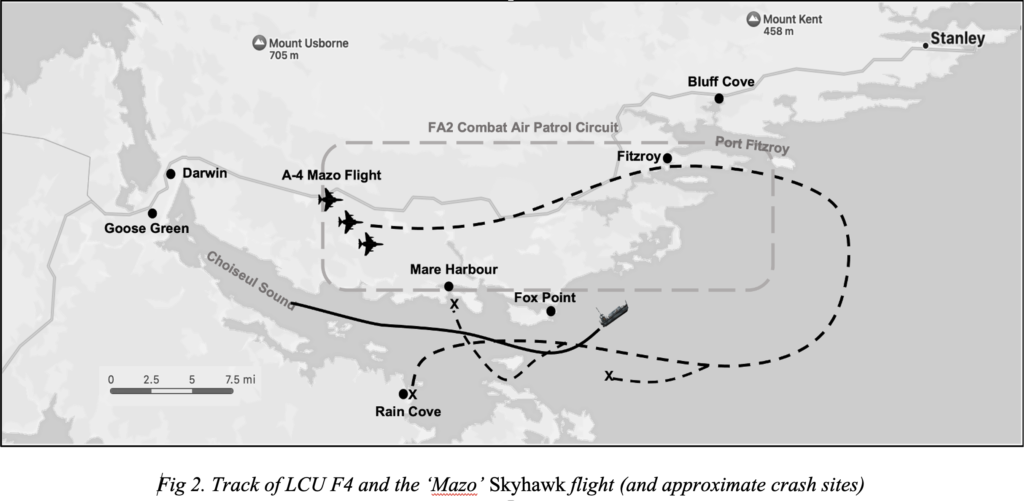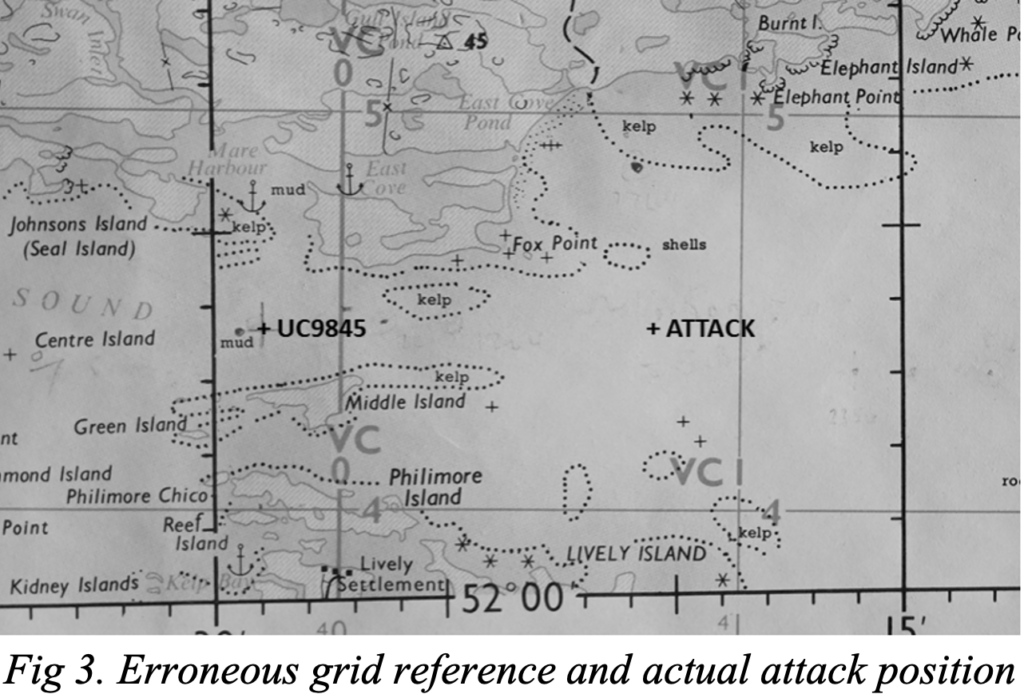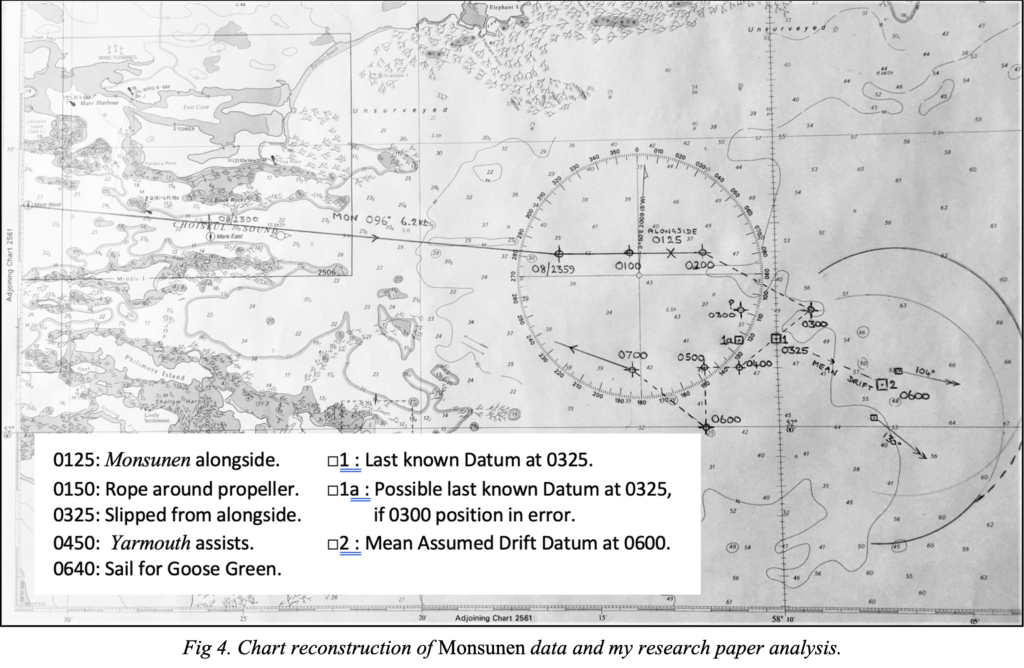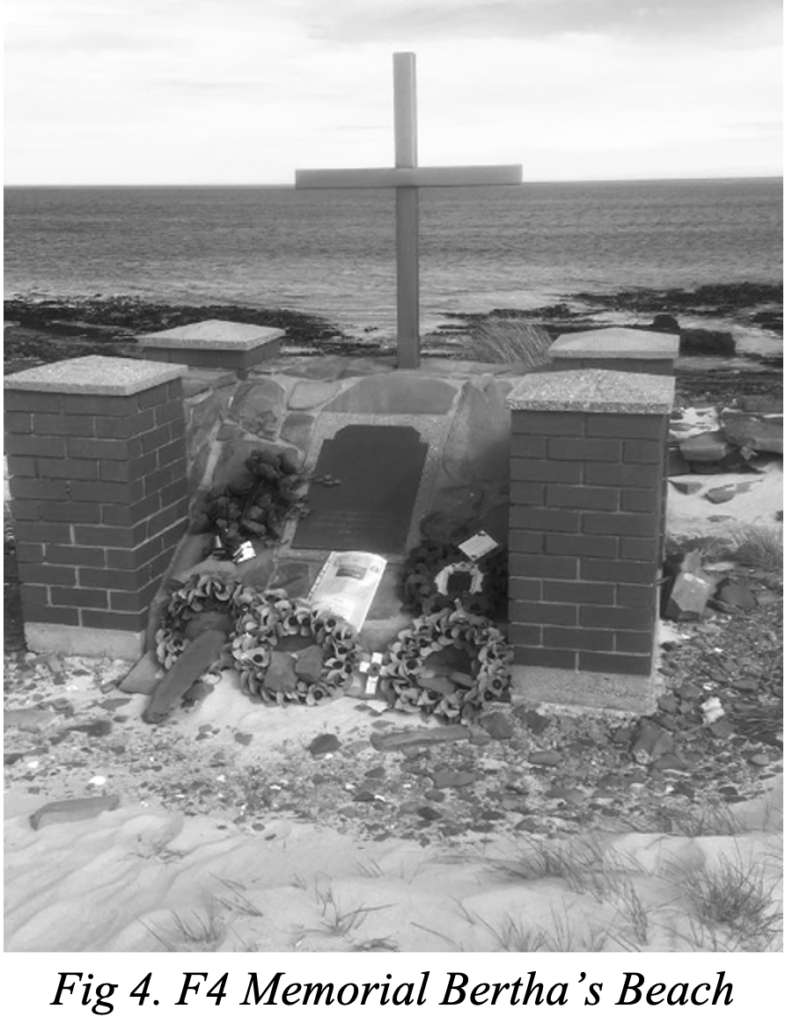Finding Foxtrot Four
By the Editor – Do the small events matter amongst the large mayhem of a war? Unequivocally yes! Our people and their memory matter. The author drawing off his more extensive research paper looks at the tragic loss of LCU Foxtrot Four and efforts to locate its war grave.
Tuesday 8 June 1982 dawned bright, clear and cold, resulting in renewed attacks by the Argentine Air Force. The British Forces were advancing towards retaking Port Stanley. But any optimism that day was soon to be dashed. The Argentine attacks on the Landing Ships Logistic RFAs Sir Galahad and Sir Tristram off Fitzroy are well documented. What is less well known is that a subsequent formation (Mazo Flight) of four Argentinian A-4 Skyhawks was mounted, two of which attacked and struck LCU F4 (commanded by Colour Sergeant Brian R Johnston QGM Royal Marines) as it sailed out of Choiseul Sound bound for Fitzroy.
LCUs often operate as independent commands under a Colour Sergeant (CSgt) or Sergeant Royal Marines (RM) of the RM Landing Craft Squadron, with a crew of seven. On this occasion MEA(P)1 ‘Jesse’ James was onboard to assist the young LMEM Miller with F4’s sometimes temperamental engines making it eight. With the loss of many support helicopters in the sinking of MV Atlantic Conveyor on 28 May, the LSLs together with 8 LCUs from Fearless and Intrepid, became vital logistic support assets.

F4 was supporting 5 Bde HQ, taking personnel and equipment from Darwin-Goose Green to Fitzroy. Having returned overnight 7/8 June to Goose Green, the Royal Signals communications Land Rovers were embarked to be taken forward. F4 should not have sailed in daylight, but CSgt Johnston was made forcefully aware of the pressure to get this vitally important communications equipment to Fitzroy as soon as possible. So he took the fatal risk of proceeding in the late afternoon daylight on 8 June.
At dusk Argentinian Skyhawks sighted F4, by then out to sea off Choiseul Sound. Two attacked with 500lb bombs, one scoring a direct hit on F4’s stern, killing six of her complement and injuring three others of the 17 Servicemen onboard.
An account states that, only minutes before the attack, CSgt Johnston showed F4’s location to a Royal Engineers officer,[4] telling him, somewhat ironically, that F4 was off Johnson’s Island in Grid Position of UC9845 (see Figure 3).[5] The officer returned a few minutes later to the shelter of a Land Rover. The attack took place approximately 20 minutes afterwards, meaning that F4 had travelled at least 2.5nm at 7.5 – 8kts.
F4 was attacked from ahead (i.e. from the east and towards the entrance to Choiseul Sound) initially at a relative angle off the port bow but, when the aircraft were sighted, the helm was put hard over to port in an evasive manoeuvre that so nearly succeeded. However, one bomb hit F4’s starboard quarter.5
The timing of the attack has been variously recorded in other accounts as between 1920 and 2050. However, Fl Lt David Morgan’s account is clear and precise5 – it was 1947-50, outside Choiseul Sound, at 2.5nm ESE of Fox Point (see Figure 2). ‘Mazo’ flight flew over Bluff Cove without dropping bombs; then flew south towards Lively Island. F4 was on a heading of approximately 070° as per Fig 2. They spotted F4 and started a very rushed attack. Morgan (Sea Harrier ZA177) and his wingman Lt Dave Smith RN (Sea Harrier XZ499) spotted them during their turns at the eastern end of the CAP and dived down onto them heading around 210°. “I watched impotently, urging my aircraft onwards and downwards, as the first A-4 opened fire with his 20-mm cannon, bracketing the tiny matchbox of a craft. My heart soared as his bomb exploded a good 100ft beyond them, but then sank as a further A-4 ran in behind him. The second pilot did not miss, and I bore mute and frustrated witness to the violent fire-bright petals of the explosion, which obliterated the stern, killing the crew and mortally wounding the landing craft.”
The bomb exploded in the engine room. Helmsman Marine Quigley was blown overboard but despite being wounded, managed to swim back and boarded F4 across the remains of the damaged stern and engine room. The bomb destroyed most of the starboard quarter hull section and the engine room, along with the entire after part of the wheelhouse and damaged the radio room, putting its equipment out of action. The explosion further damaged the internal bulkhead between the engine room and accommodation space. The blast expanded the opening containing the ramp wire recovery hatch in the removeable, bolted, forward bulkhead leading to the welldeck,[6] through which Marines Griffin and Cruden were extracted from the crew accommodation. Griffin had sustained fatal injuries and Cruden sustained a gashed head.[7],[8] Five others of the crew were killed instantly. Small fires started in the engine room and accommodation area, which were put out by the embarked forces using the LCU and Land Rover fire extinguishers.
It was still light, but the sun was very low. Morgan shot down the first A-4 before it could re-attack, then accounted for a second as it tried to evade towards Mare Harbour. The third, which Morgan believes was the one that hit F4, was shot down by Smith near Lafonia and crashed in Rain Cove. None of the three Argentine pilots shot down survived.5 Morgan immediately sent an SAR request. Consequently, the important time and position of the attack are accurately established as 1947 – 1950, 115° Fox Point 2.5nm.

(Two Royal Marine crew, eight Royal Signals and a Royal Engineers Officer. A Royal Signals account states that“F4 was over a mile from land in the gathering dark. Both life rafts had been damaged, and no alarm message had been sent.” The Signallers moved the Land Rovers forward in an attempt to counterbalance and raise the stern and slow the rate of flooding. Marine Quigley checked the LCU forward watertight spaces vents to ascertain if they have been ruptured. No air escaped, so a degree of forward buoyancy remained.8
Next, Lance Corporal Signallers, managed to get a Clansman radio working and tuned into a 5 Inf Bde frequency. A Mayday call for assistance was sent⁷. This was received by 5Bde around 2035: “VC04 [Grid square for Fox Point] – LCU sinking off Fox Point. Eastern end of Sound (UC 9845 afternote 2032). SH tasker dealing with.”[9] MVMonsunen[10]received a directive on sailing at 2040 to proceed and assist.[11] The LCpls did not give a Grid Reference; reporting the attack as “off Johnson’s Island.” It can reasonably be assumed that an operator at 5 Bde converted this into UC9845 as above, when F4 would actually have been at least 2.5nm further east in the originally recorded attack position as “off Fox Point.”
A Royal Signals account states that they received a message that two light helicopters (Scout or Gazelle) from 656 Sqn AAC would attempt to locate F4 to pinpoint its position for the RN rescue helicopter. A light was to be shown by survivors to aid these small helicopters when they were heard, but it was not seen. If they had been sent to GR UC9845 (See Fig 2) as the search position and then not located F4 in the dark, then F4 was indeed further along her outbound navtrack. But soon after, an RN Sea King, was heard and F4’s light was seen. The Aircrewman lowered himself onto F4 to ascertain the physical state of the survivors and to conduct the recovery briefing. It took about 30 minutes to lift all the survivors into the helicopter. The survivors were flown first to Ajax Bay Field Hospital to land the three injured and then on to Fearless.[12],[13]
Five and a half hours after the attack, Monsunen detailed the damage after going alongside F4 in a signal to Fearless. “Sea water was entering the vessel from aft, causing her to be down at the stern. F4 had been hit on the quarterdeck aft behind the bridge; devastating the steering gear compartment, engine room and crews’ quarters. The forward part of bridge and transom were only just hanging on. The forward part of the bridge had only suffered minor whip damage. The after part of welldeck was awash to a depth of approximately three feet but welldeck itself was mostly dry. The Land Rovers had taken some minor shrapnel hits.”
F4 was slowly sinking and Monsunen’s civilian skipper advised strongly against girding F4 stating that F4’s 115 tons would take his vessel (326 tons) down also if F4 sank. Monsunen was also overloaded with 500 fully armed personnel and equipment embarked. The attempted tow was aborted after the rope fouled Monsunen’s propeller. Next, Yarmouth, having closed to conduct Naval Gunfire Support, came across Monsunen. Yarmouth’s divers cleared the screw at 0630. By then, the requirement for Monsunen to depart this exposed position and return to Goose Green before dawn at 1112 become imperative.
Monsunen signalled F4’s last known position as “in vicinity of 51°59’S 058°12´W, drifting on a heading of 130° (i.e., not in accordance with a NE/SW current), with a list of 10° to starboard and well down by the stern and the deck tilting at approximately 15° upwards. Vessel is very slowly sinking.”[14] She returned 17 hours later to conduct a radar and visual search for F4. This extended 19nm out from the entrance of Choiseul Sound on 10 June. Even taking a conservative 4nm range for Monsunen’s radar to detect an object low in the water, the area covered was extensive at some 184 sq nm and nothing was found.

Limited post-war surveying of areas around Choiseul Sound has taken place, but nothing found resembling an LCU-shaped wreck. HMS Ledbury searched Choiseul Sound entrance in August 1982 and HMS Enterprise conducted a Falkland Islands survey in the area in 2011-2012 and again in 2017. HMS Protector has alsospent time searching in previous deployments and concluded that F4 is lying entangled in kelp, an area notoriously difficult to search. All were most probably looking in the areas contrary to the findings of my research into the sinking, which concludes that the datum is out to sea and well clear of kelp beds.
In early 2020 during the Overseas Territories Seabed Mapping Programme, the EGS Survey Company conducted a four-hour side scan survey of the last sighting datum position as an ad hoc task, but again found nothing resembling an LCU size wreck. Notably no Magnetic Detection System was employed and the allocated time was very limited, so preventing an effective expanding search.
A Hydrographic assessment is that, if F4 did sink in the vicinity of the datum, then the prevailing strong currents could have swept it further away. However, this does not appear to account for the shallowness, which would minimise the current’s effect. However, data recording using an Acoustic Doppler Current Profiler (ADCP) over a complete period of 30 days would provide a detailed tidal stream and currents analysis in the area that could be used to ‘back predict’ to 8-9 June 1982
So this research resolves the many inaccuracies included elsewhere concerning F4’s loss. The location and timing of the attack is established accurately and those for the rescue as highly probable. Charted data and speed times distance calculations confirms Monsunen’s last definite sighting as 51°58′.5S 058°10’W, and a new mean calculated position of potentially sinking as 51°59′.3S 058°07′.2W.
Data collated from this research results in two credible outcomes of Finding Foxtrot Four:
- First, from the ‘attack’ to ‘slipping’ was 7 hours 25 minutes, by when F4 was declared to be showing significant signs of imminent foundering. Taking F4 sinking within a conjected 3 hours of last being sighted at 0640 on 9 June, a probability area was calculated as to where F4 might have foundered in 60m to a sand and rock seabed. To substantiate this, the Ships Stability Team at Abbeywood[15] are conducting modelling to assess how the known damage would affect the rate of sinking. If then combined with accurate oceanographical current data and seabed identification by deploying an ADCP, these datums could be further refined and a search conducted. Perhaps then F4 may be found.
- Or second, conceivably F4 did not sink for some time, remaining buoyant due to the watertight void spaces remaining undamaged or with only very minor leakage. In which case F4 is lost forever in the Southern Ocean.
Nevertheless, should the wreck of F4 eventually be located, then it should be left in situ as a designated War Grave.

Marine Griffin is known to have died shortly after being extracted from the crew accommodation and his body remained onboard the wreck. It is probable that the other five crewmen, instantly killed in the action, were lost overboard due to the explosion. Perhaps, the location of the attack off Fox Point should be regarded as their last resting place. But with the attack now unequivocally established as being off Fox Point, it is apt that the second F4 Memorial is at the peaceful setting of Bertha’s Beach. It is maintained by the deployed FI Garrison Forces, and a replacement plaque was attached in March 2022. The original Memorial remains at Lively Island Settlement.

It is hoped that the bereaved families now have the most accurate account of how, when and where their gallant relatives made the ultimate sacrifice.
CDR JOHN PRIME RN (Rtd)
Acknowledgements
Capt J S Kelly RN (Commander HMS Fearless 1981-82)
CPO A Ashdown (SeaKing c/s VZ’s Aircrewman)
RAdm PJ Sparkes (Acting CE and National Hydrographer at UKHO)
[1] Lt Ian McLaren RN – HMS Fearless 1981-82 / CO MV Monsunen 1982- Monsunen’s Ship’s Log and numerous interviews.
[2] RAdm ESJ (Jeremy) Larken Visiting Reader Kew Archives – Extracts of HMS Yarmouth’s Ship’s Log 8 – 10 June 1982, Interviews.
[3] PO Radar Peter J Green HMS Yarmouth’s Diary – http://radarmalvinas.com.ar
[4] F4 Army Survivors – Interviews and Material – Capt Carel P Bouwens Royal Engineers (5 Bde HQ G3 1982) & Cpl Robert Taylor Royal Signals & The Royal Corps of Signals The Wire and The Journal Sep 82.
[5] Fl Lt David HS Morgan RAF (800 Sqn) 1982– personal interviews and emails & https://weaponsandwarfare.com/2017/01/04/the-last-british-dogfight/&
http://www.globalaviationresource.com/reports/2010/davidmorganp3.php
[6] F4 Army Survivors – Interviews and Material – Capt Carel P Bouwens Royal Engineers (5 Bde HQ G3 1982) & Cpl Robert Taylor Royal Signals & The Royal Corps of Signals The Wire and The Journal Sep 82.
[7] Monsunen (HMS Fearless) Royal Navy Crew 1982 – Interviews – SLt P Jones; RO1(G) William C Kewn; & AB(S) C-J Moss
[8] F4 Crewmen Survivors – Mne Jim Quigley RM & P (Titch), Mne A Cruden RM – Interviews.
[9] Lt Col S Ewen Southby-Tailyour RM (OC Task Force Landing Craft Squadron) 5 Brigade Logbook Kew Archives
[10] MV Monsunen was a 326 ton coaster seized by the Argentinians as a resupply vessel and then recaptured by HMS Brilliant and Yarmouth and a Lynx inserted SBS team on 22 May 1982
[11] Lt Ian McLaren RN – HMS Fearless 1981-82 / CO MV Monsunen 1982- Monsunen’s Ship’s Log and numerous interviews.
[12] F4 Army Survivors – Interviews and Material – Capt Carel P Bouwens Royal Engineers (5 Bde HQ G3 1982) & Cpl Robert Taylor Royal Signals & The Royal Corps of Signals The Wire and The Journal Sep 82.
[13] F4 Crewmen Survivors – Mne Jim Quigley RM & P (Titch), Mne A Cruden RM – Interviews.
[14] Lt Ian McLaren RN – HMS Fearless 1981-82 / CO MV Monsunen 1982- Monsunen’s Ship’s Log and numerous interviews.
[15] Lt Col Richard Thurstan RM (4th Assault Sqn RM OC 2018 – 2020) & Mr Tony Moore (11 ATT Sqn) – LCU Mk 9 data and Ships’ Stability Team in Abbeywood (DE&S).

